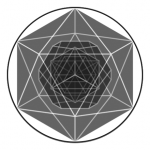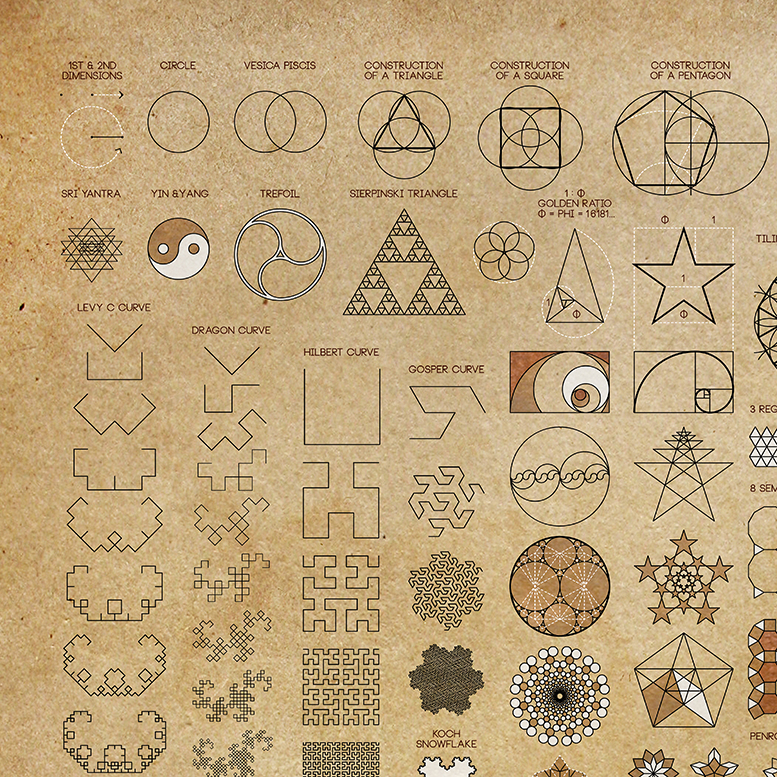The science of Sacred Geometry is growing more popular every day but few people have a real grasp on what is really meant by either “Sacred” or “Geometry.” Sacred Geometry is the study of the patterns, shapes, and ratios that we often find in the natural world. Whether it’s the golden ratio (phi, ø) in the human face and hands, or the “flower of life” found in the stacked atoms of certain crystals, or the fractal branching of trees, neurons, and rivers, there are certain shapes and forms that we can’t help but notice in our world.
In its ancient understanding, Sacred Geometry’s geometry itself was considered a window into the mind of God/s. If there were certain physical laws in nature, they must have existed because they were pleasing to God. Numbers and shapes were therefore ascribed specific meanings with correspondences to religious traditions, and these perceived truths guided the creation of spiritual spaces and spiritual art. This is why cathedrals often have a rose window with 12-sided symmetry (symbolizing the 12 apostles as well as the prevalence of certain symmetries in nature), why Buddhists create elaborate geometric mandalas symbolizing the universe, and why the pyramids of Egypt contain an array of important universal ratios implicit in their arrangement.
In the modern usage, Sacred Geometry remains associated with a great many spiritual paths, with an even broader set of interpretations and affiliations. It is found in almost every art, on products that are marketed both cynically and sincerely; it is used by gurus and charlatans alike, religious paths both respected and dubious. Many of these paths have their own ideas of what the numbers 1, 2, 3, 4, & 5 mean, or why these various patterns, shapes & ratios are significant. Nearly all of these paths borrow from one another—from the lunatic fringe to the high establishment—so much so that it can be hard to tell who is who, what is what, and what, if any of it, is real.
Many spiritual truths echo geometric discoveries that have come from secular science. Benoit Mandelbrot coined the term fractal after building on the work of Gaston Julia and others. Fractals are self-similar figures that display remarkable forms at a macrocosmic and microcosmic levels, a theme that echoes many esoteric spiritual traditions, perhaps most notably “as above, so below.” Likewise many scientific truths have originated in spiritual inquiry. Buckminster Fuller, who explored the concept of divinity in his book No More Secondhand God, explored what was known about the arrangements of atoms at the smallest scale, which led to the invention of geodesic domes and expanded the potential of material science.
Mathematicians and scientists have long studied these observable forms, because they are so often related to the questions they are trying to answer. Monks and shamans have long studied these observable forms, because they are so often related to the questions they are trying to answer. Why is the world the way it is? What is the cause of life on Earth? How do plants and animals grow from single cells? What will happen in the future? What is happening very far away? Is it possible to know anything with certainty? How can we achieve the miraculous?
We are perhaps experiencing a renaissance of sorts in the agreement between some contemporary scientific thought and some contemporary spiritual perspectives, but it is my historical reading that those pursuits were never very far from each other. Both science and spirituality can be read as an interaction with mystery, a dance of ignorance and certainty and intuition. Both are at their best when they focus on what works. Both have an elite class of excellent practitioners who are sought out for their wisdom. While the paths of scientific and spiritual inquiry differ they are certainly not divergent. Sharing lessons from these different paths can only strengthen our understanding of the universe.
Why is this page called Naked Geometry?
We started Naked Geometry to make work about what is known. It began as geometric artwork largely unadorned by any personal subjective meaning applied to the individual numbers or shapes. Over the years of collaboration we have grown into a collective of geometric artists. We celebrate all observable geometry, and search for geometry not yet revealed. We are not interested in telling people what the number 7 means, or what gods to worship, or why flowers are beautiful. We seek simply to point to the splendor of pattern and interconnectedness, the emergent powers of life itself, this obvious beauty we are surrounded with.
At Naked Geometry, we each have our own inner systems of unifying science and art and love and devotion, and while it makes us happy, we don’t know whether or not any one path will work for you. If you are walking on a path, and it is serving you well, and increasing your understanding and awareness and (hopefully) care of the world, than there is no reason for us to suggest you do otherwise. However, most paths agree that the chlorophyll molecule is 12-sided, a pineapple grows as the shape of a spiral phyllotaxis and, for some reason, flowers are very beautiful. So we stick to pointing out the verifiably awesome, and making art with it!
As an actual day to day practice, the essence of what a sacred geometer does is still very close to what one fan said, which is “to make anything constructed with the Euclidean tools [compass, straight edge, pen or similar], where only the first center & radius are chosen by the geometer, and all other forms are created from information held within the shapes themselves.” This is the area of inquiry in a nutshell, whether we’re using a compass or a computer. Studying pure geometry means meditating on the basic shapes, learning their unique behaviors, appreciating their commonalities, making use of their combinations. From the basic building blocks of lines, circles, polygons, stars & solids, the miraculous arises. “Every moment and place says, Winter 2013 (edited Winter 2017) James Gyre
Prints
Put this design in your carpet!”
– Rumi
14 thoughts on “What is Sacred Geometry?”
Leave a Reply



I love this introduction. II think it is one of the best things writings you’ve done. Godspeed Nakgeo!
Awesome. I love the parts of “unifying science and art and love and devotion,” Keep it up!
I love that you aren’t trying to hang a belief system on the geometry of nature. You expressed these complicated understandings of the mysteries of life very succintly and completely. Thank you so much, from deep in my soul!!
Thank you for your lovely share and the work you do… I’m going exploring
Very informative and beautiful work that truly has meaning
Met you guys at some craft store in Cranberry, PA. You guys are amazing and so is your work. I am definitely satisfies with the necklace I bought, I have been wearing it ever since I bought it. I will definitely be ordering more products in the future. Keep being awesome.
Sacred geometry should always be in our lives!
Excellent introduction. I deeply appreciate your gentle respectfulness and the scope of your understanding.
Is Sacred Geometry really a science? I don’t find it listed among Commutative Geometry, Non-Commutative Geometry, and others…
Because it’s adding emergent properties to mathematical shapes, patterns, and forms…Sacred Geometry seems to have left the realm of empiricism and entered (at least partially) the realm of assumption. I find it extremely fascinating, thought-provoking, objective, and calming – don’t get me wrong – but I don’t think introducing SG as a “science” in the first line of the home page’s introduction is necessary or accurate.
Defining a practice as science or not is really about the specific decisions of the practitioner. Is the average person engaged with sacred geometry considering it primarily as a science, and holding it to scientific standards? Absolutely not. Did some people approaching sacred geometry do so as a scientific pursuit? Absolutely. I think it deserves the label, even if it isn’t officially listed by the Department of Approved Sciences™.
I think the whiff of sacred geometry overlapping with faith concerns some people, and not without reason. Consider though that some people of faith also require accurate observations of their world, and aren’t looking for fudged numbers or subjective definitions. Greater rigor in describing nature helps them worship with a closer understanding of what they consider creation, and rather than being threatened by new observations, they celebrate them as fodder for further appreciation of the genius of what they consider the creator/s.
Similarly, most scientists have a sense of reverence for the natural world and it’s common forms, a reverence only more informed by direct observation. The bulk of the historical creation of what became grouped as sacred geometry came with a practice that is indistinguishable from science from my perspective, and so I feel labeling it as such is both necessary and accurate for historical reasons, but in part to limit the term being claimed only by those who seem more concerned with selling snake oil than checking their proclamations for accurate geometry.
It would be MORE accurate to call sacred geometry BOTH an art and a science, as I think the practice often meets both definitions, but not because sacred geometry isn’t, in practice, a science.
I think geometry and math are the language of the Universe
Greetings and salutations from central Kansas, USA! Found you via a 2018 video by pocket83 (on his second channel) on YouTube. Yet more interesting things to spend my money on. And for the record, I am a more secular appreciator than a spiritual one 🙂
Well put! Showing people that there is a path and encouraging them to make discoveries on their own, the way it unfolds for them is the right amount of information to put online. Appreciate it:)
Found my way here from Imgur key term Megatron 🙂
Wow, I have so many questions! Thank you for your time and patience, your illustrations of the point where science and art and creation diverge are priceless.